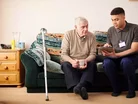The role of a care coordinator

It’s been described as the single most important role involved in the care of a patient, covering everything from medicines and assistive technology needs to food insecurity and housing issues.
Essentially, a care coordinator supports high risk individuals by identifying their needs in a patient-centred way. When people think of care coordination, they typically think of improving one’s health by getting them connected with medical services. In fact it’s a wrap-around approach where all the person’s needs are considered, from medical to social determinants of health needs like food and physical environment.
“Care coordinators have the responsibility of building rapport over extended periods of time, being in consistent communication and “showing up” for the patient population being served” explains Brooke Sabia from Activate Care.
As the name suggests, care coordinators need to liaise with other care team members and services, sharing data and collaborating to ensure the patient receives the best possible care. Brooke says this is made possible with technology, so they can “stop becoming data clerks and more effectively do their job.”
Day-to-day tasks can be unpredictable. “We are dealing with people first, and systems and machines second” Brooke explains. “The typical day-to-day consists of sitting down at your workstation and pulling up whatever program you are using to monitor your patients. If you are really in bad luck, you are probably using an outdated, non-HIPAA compliant database like Microsoft Excel or sticky notes! You look at any overdue tasks or things you may need to follow up on from the previous day, along with any tasks you need to accomplish on the current workday.
“Patients are assigned on a daily basis and care coordinators are in charge of exhausting all efforts regarding different forms of outreach in order to establish a connection, which includes house visits.
“The process is invasive and uncomfortable for both parties, but often a requirement so that care coordinators can confirm no stone was left unturned when attempting to contact the patient. Albeit uncomfortable, this ensures no patient is falling through the cracks. However, these unexpected visits open up an entire layer of uncertainty, nervousness, and quite frankly, not knowing what could be going on behind closed doors, especially if alone - which is usually the case.”
Having only minimal information about the patient can cause problems. Sometimes it isn’t readily available and the patient has to re-explain their story, forcing them to think about any traumatic experiences that are relevant to their care. Other times the patient chooses not to disclose very much.
“A prime example of patients withholding information, although they have the right to do so, is when I went to an individual’s house who was on a temporary visa” Brooke explains. “We spent the first hour talking about his story and what services he currently has and what services he needs. After that hour I noticed my hospital’s magnet on the fridge, with a coworker’s name written on the magnet, labelled “case manager.” I asked if he was working with us already, and he said, “oh yeah, that’s my case manager, she brings me food and comes and cleans up my house!” Only after an hour of talking about getting him set up with a home health aide and delivered meals, did I find out he was already getting this – meaning I would have been duplicating services.”
“How nice would it have been for us to spend that hour addressing other needs, such as housing or the lack of heating in his home” Brooke adds. “Asking individuals to start from scratch to tell us about who they are, with only 1-2 hours to get the necessary information, is not a good use of time. There has got to be a better way.”
Brooke explains that an ideal system would show if contact has already been made, if members are accessing homeless services, and whether their EHR shows any red flags. “I would be spending less time trying to track down patients because I would have visibility into other systems or services that they are utilising”, she says.
“Care coordinators need to have the technological capability to connect with a member in other data-compliant ways than just phone calls. The caregiver, health care proxy, guardian, adult child, or friend also should have the option of being involved. Some of those healthcare technology programs give that option by allowing you to communicate with the member through the actual care plan itself. Case managers know the more appropriate people involved, the higher chance their patient has at successfully meeting their needs” Brooke says.
As well as having access to relevant information, the most important aspects of a successful relationship between the care coordinator and the patient are referrals, collaboration with other partners such as with behavioral health case managers and nurses, and delivering patient-centred care. In the case of the latter, Brooke says this is the most successful type of care. “This means letting the patient be the captain of their own ship, while helping them navigate the health system.”
“Care coordinators and patient navigators are typically the glue that binds all the pieces of a medically complex patient’s life together” she adds. “While providers diagnose and treat in the hospital, care coordinators and other patient-facing persons at hospitals often go beyond the four walls of that hospital or clinic, into the community, in people’s homes, and meet them where they are at, both literally and figuratively. Case managers address unmet social needs that are preventing them from getting their medical care and having a good quality of life. You build rapport with the patients and work with them to educate them on how to navigate this really complex monster called healthcare.”
Activate Care’s “A Day In The Life of A Care Coordinator:Team-based strategies across health and social care” webinar runs on Wednesday August 19. To register for free click here



